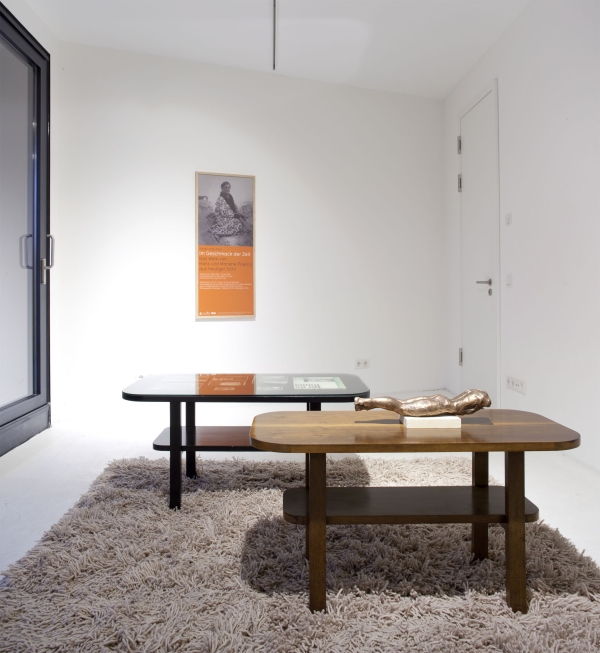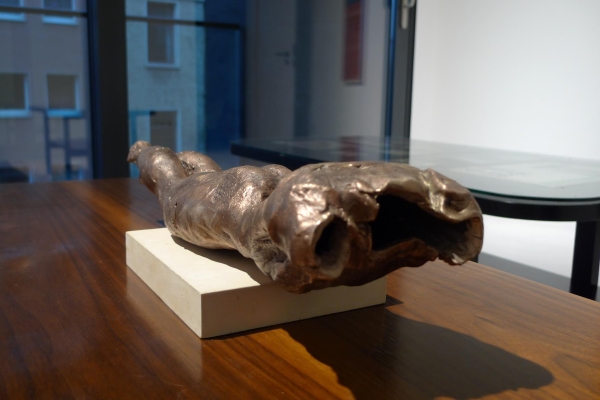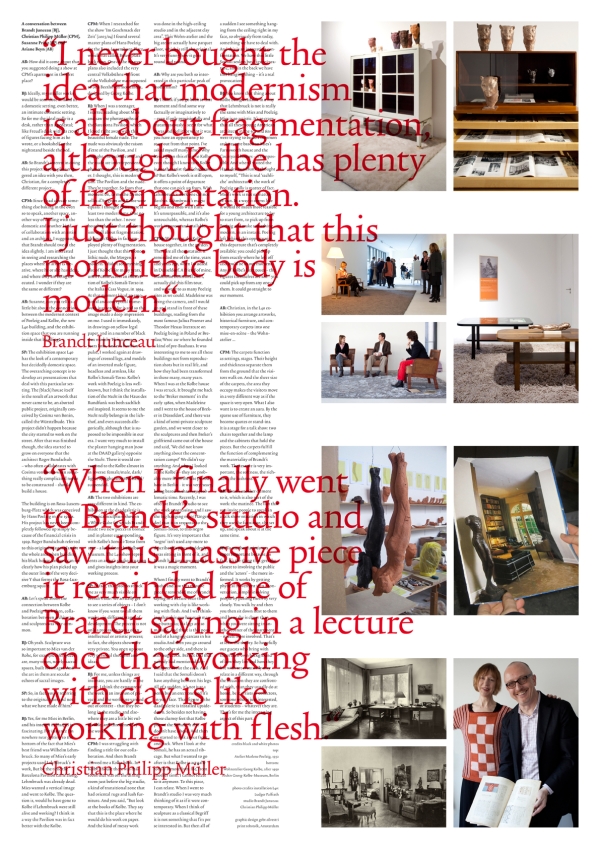
Maquette of the exhibition “Im Wohnatelier.”
“Im Wohnatelier” installation view with untitled figure fragment by Brandt Junceau, bronze, 2011; furniture designed by Marlene Poelzig; and carpet designed by Liset van der Scheer for Casalis, Buffo, 100% wool, yarn made in Germany, hand knotted in Portugal. Photo: Anita Back, Berlin.
Detail, untitled figure fragment by Brandt Junceau, bronze, 2011 on table designed by Marlene Poelzig. Photo: Anita Back, Berlin.
“Im Wohnatelier” installation view with untitled drawings by Brandt Junceau, 2010-2011, and untitled terra cotta and painted terra cotta busts, 2010-2011; kitchen cabinet and chairs designed by Marlene Poelzig; and foreground carpet designed by Liset van der Scheer for Casalis, Spira, 100% wool, yarn made in the Netherlands, pass tufted in the Netherlands. Photo: Anita Back, Berlin.
“Im Wohnatelier” installation view with untitled drawings by Brandt Junceau, 2010-2011, untitled terra cotta and painted terra cotta busts, 2010-2011; kitchen cabinet and chairs designed by Marlene Poelzig; and foreground carpet designed by Liset van der Scheer for Casalis, Extase, 100% mohair wool, yarn made in France, hand tufted in Portugal. Photo: Anita Back, Berlin.
Detail, untitled terra cotta and painted terra cotta busts by Brandt Junceau, 2010-2011; kitchen cabinet designed by Marlene Poelzig; and carpet designed by Liset van der Scheer for Casalis, Extase, 100% mohair wool, yarn made in France, hand tufted in Portugal. Photo: Anita Back, Berlin.
“Im Wohnatelier” installation view with untitled busts by Brandt Junceau, bronze and painted bronze, 2010-2011; chairs and cabinet designed by Marlene Poelzig; and carpet designed by Liset van der Scheer for Casalis, Galaxy, 75% polyester, 20% wool, 5% cotton, yarn made in Italy, hand tufted in Portugal. Photo: Anita Back, Berlin.
Detail, cabinet with untitled busts by Brandt Junceau, bronze and painted bronze, 2010-2011; cabinet designed by Marlene Poelzig. Photo: Anita Back, Berlin.
Liset van der Scheer with carpet samples, tables designed by Marlene Poelzig, Casalis carpet, Buffo, 100% wool, yarn made in Germany, hand knotted in Portugal.
Exhibition poster (front) designed by gebr.silvestri, Amsterdam.
Exhibition poster (reverse) designed by gebr.silvestri, Amsterdam.
Im Wohnatelier
19–27 March 2011
Verein zur Förderung von Kunst und Kultur am Rosa-Luxemburg-Platz, Berlin
Exhibition curated by Christian Philipp Müller with works by Brandt Junceau and furniture by Marlene Poelzig on carpets by Casalis
Artists’ conversation excerpted in the publication documenting “Im Wohnatelier,” at L40, Berlin
Participants:
Brandt Junceau (BJ)
Christian Philipp Müller (CPM)
Ariane Beyn (AB)
Susanne Prinz (SP)
AB: How did it come about that you suggested doing a show at CPM’s apartment in the first place?
BJ: Ideally, my smaller works would be seen close at hand in a domestic setting. So for me the ideal setting really is a desk, not a pedestal; like Freud’s desk with its crowd of figures facing him as he wrote, or a shelf or even better, a nightstand beside one’s bed. An apartment, better than a gallery.
AB: So Brandt’s interest in doing this project at your place triggered an idea with you then, Christian, for a completely different project…
CPM: Since I had already something else baking in the oven, so to speak, another space, another way of dealing with the domestic and another kind of collaboration with an artist and an architect, I suggested that Brandt should tweak the idea slightly. I am interested in seeing and researching the places where an artist is creative, where he or she has ideas, and where they are being executed. I wonder if this the same or different?
AB: Susanne, can you tell us a little bit about the connection between the modernist context of Poelzig and Kolbe, the new L40 building, and the exhibition space that you are running inside that building?
SP: The exhibition space L40 has the look of a contemporary, but decidedly domestic, space. The overarching concept is to develop art presentations that deal with this particular setting. The (black) house itself is the result of an artwork that never came to be, an aborted public project, originally conceived by Cosima von Bonin, called the “Würstelbude.” This project didn’t happen because the city started to work on the street. After that was finished though, the idea started to grow on everyone that the architect Roger Bundschuh — who often collaborates with Cosima von Bonin when something really complicated needs to be constructed — should build a house.
The building is on Rosa-Luxemburg-Platz, which was conceived by Hans Poelzig in the 1920s. His project has never been completely followed up simply because of the financial crisis in 1929. Roger Bundschuh referred to this original masterplan for the whole area when building his black house, which you can clearly see by how he actually picked up the outer lines of the very decisive “Y” that forms the Rosa-Luxemburg square.
AB: Let’s speak about the connection between Kolbe and Poelzig. Back then, collaboration between architects and sculptors was very common…
BJ: Oh yeah. Sculpture was so central and so important to Mies van der Rohe, for example. His spaces are so often, in effect, in logic and feeling, sacral spaces. And his placement of contemporary art echoes the hierarchy of sacral images.
SP: So, in fact, you’re referring to the original Mies and not what we have made of him?
BJ: Yes, Mies in Berlin, and his placement of images, the totemic centrality of images in his work, is fascinating. I’m nowhere near getting to the bottom of the fact that Mies’ best friend was Lehmbruck. Mies’ earlier projects used Lehmbruck’s work. But by the time the Barcelona Pavilion came along, Lehmbruck was already dead. And he needed some kind of vertical element, and went to Kolbe. The question is, would he have gone to Kolbe if Lehmbruck were still alive and working? I think the Pavilion is in fact better with Kolbe, and practically inconceivable without the “Morgen.”
CPM: When I researched for the show “Im Geschmack der Zeit” (2003-2004) I found several master plans of Hans Poelzig for the Rosa-Luxemburg-Platz, which was called Bülowplatz back then. One of the master plans also included the very central Volksbühne. In front of the Volksbühne was a Beethoven monument designed by Georg Kolbe.
BJ: As a teenager I started reading about Mies and saw the photographs of the Barcelona Pavilion, which I loved right away, with this beautiful female nude. The nude was obviously the raison d’être of the Pavilion and I thought the architecture and the nude are interdependent phenomena that belong together. This is Modernism. The Pavilion and the nude. They’re together. So from that moment on, to me the “Demoiselles d’Avignon” and Kolbe were equivalently modern. I thought there were at least two Modernisms. One no less than the other. I never bought the idea that modernism is inherently fragmentary (although Kolbe too has plenty of fragmentation). I thought the monolithic body is Modern.
Then I didn’t see anything else of Kolbe’s for many years, until I came across an illustration in Italian Casa Vogue of Kolbe’s “Somali-Torso.” At that moment I had an emotional and conceptual framework just ready for it, so the piece (the image rather, like the image of the Pavilion) made the deepest impression on me. I used it immediately in drawings on yellow legal paper and in a number of black wax models. This summer, years later, under a fresh impulse, I worked again at drawings of crossed legs, and models of an inverted male figure, headless and armless, like Kolbe’s “Somali-torso.”
Kolbe’s work with Poelzig is less well-known, but I think the installation of his “Nacht in the Haus des Rundfunk” was both matter-of-fact and inspired. It seems to me that the “Nacht” really belongs in the lichthof, and even succeeds allegorically, although that is supposedly impossible in our era. I want very much to install the “Hangende” (now at the Daadgalerie) opposite the “Nacht.” There it would correspond to the Kolbe almost in reverse: female:male, dark:light, upright:inverted, based:suspended.
In Berlin it’s easy to think about Kolbe because he is around, because the Kolbe house is here. And there are pieces in situ here, unlike Lehmbruck. But everyone realizes anyway that Lehmbruck is beyond important, he is magical. And so when institutions wanted Lehmbruck, there were posthumous casts made. Kolbe was, more than Lehmbruck, at one with his time. But If there had not been a few people who cared about Lehmbruck, he would have never have been remembered. There were only a few casts in stone, casts that he made himself, in his lifetime, but very few bronzes.
AB: The two exhibitions are very different in kind. The exhibition at the Daadgalerie is a classical sculpture show in a White Cube for which Brandt made two new pieces in bronze and in plaster corresponding with Kolbe’s Somali-Torso from 1912 — a loan from the Kolbe Museum. The L40 show represents an artist’s studio situation and gives insights into your working process.
SP: In fact, that struck me as extremely open from Brandt’s side. We actually get to see a series of objects — I don’t know if you want to call them works — in different stages of development. The process is not only a process in terms of an intellectual or artistic process. In fact, the objects shown are very private. You open up your very personal thoughts and ideas.
BJ: For me, until things get intimate, you are hardly in the game. I like that the exposure of the work at L40 is an invasion of privacy. And that the works are yanked out of context — that they belonged in the studio, and that, torn away, they are a little bit vulnerable and threatened by the world.
CPM: I was struggling with finding a title for our collaboration. And then Brandt showed me a Kolbe book. In Kolbe’s house there was this room that was off the dining room just before the big studio, a kind of transitional zone that had oriental rugs and lush furniture. And you said, “But look at the books of Kolbe. They say that this is the place where he would do his work on paper. And the kind of messy work was done in the high-ceiling studio and in the adjacent clay area. This “Wohnatelier” and the big atelier actually have parquet floor, which is still there in the original. It’s very funny how it goes round and round.
AB: Why are you both so interested in this particular peak of modernism?
BJ: I think if you go back to that moment and find some way factually, or imaginatively to — even if only provisionally and instantaneously — see it for what it was and feel it for what it was, then you have an opportunity to start out fresh, from that point. I’ve been asking myself this question about Kolbe and Lehmbruck over and again. Why Kolbe? Why have I given so much effort to Kolbe even though I know that Kolbe is not the kind of artist that Lehmbruck is? But Kolbe’s work is open; it has an open point that one can pick up from. With Lehmbruck’s work one cannot do that. It’s Lehmbruck’s magic alone, and that begins and ends with him. It’s unsurpassable, and it’s also untouchable, whereas Kolbe’s work in its factuality is somehow porous and open, and available.
CPM: We were at the Kolbe house together, in the garden. There are all these statues. It reminded me of the time, years and years ago, when I started my research on Hans Poelzig in Düsseldorf. A friend of mine, Madeleine Bernstorff, actually did this film tour, and we went to as many Poelzig sites as we could. Madeleine was doing the camera, and I would go and stand in front of these buildings, reading from the most famous Julius Posener and Theodor Heuss literature on Poelzig being in Poland or Breslau/Wrocław where he founded a kind of pre-Bauhaus. It was interesting to me to see all these buildings not from reproduction shots but in real life, and how they had been transformed in those many, many years. When I was at the Kolbe house I was struck. It brought me back to the “Breker momen”’ in the early 1980s, when Madeleine and I went to the house of Breker in Düsseldorf, and there was a kind of semi-private sculpture garden, and we went in and then Breker’s girlfriend came out and said, “We don’t know anything about the camps.” We didn’t say anything. And when I looked at the Kolbe’s — they are probably more from the late period here in Berlin — it was very heavy, being based in that very problematic time. Recently, I was often at Brandt’s to see the work progressing in the studio, and I saw the big hanging man (“Hängender”) that is in response to the “Somali-Torso,” to this negro figure. It’s very important that “negro” isn’t used anymore to describe this piece. Suddenly I was sitting in front of it, and Brandt had just unwrapped it: it was a magic moment.
When I finally went to Brandt’s studio and saw this massive piece it reminded me of Brandt saying in a lecture once that touching clay is like touching meat. And I was thinking that this guy has such massive buttocks; his legs are so massive. And there is this postcard of hanging meat in his studio. And then you go around to the other side, and there is this huge cock. Brandt said that nobody had mentioned anything yet about the cock. And I said that the Somali doesn’t have anything between his legs. All of a sudden, it’s not just a penis, but an erect one, and it’s in your face. That figure at the Daadgalerie is installed upside-down. So besides not having those clumsy legs that Kolbe put on the Somali, it also doesn’t have a head. And then we started to talk about front and back. When I look at the Somali, he has an actual ribcage. But what I wanted to go after is that Kolbe is actually totally remote from me, from another time. I cannot relate to it anymore. To this piece, I can relate. When I went to Brandt’s studio I was very much thinking of it as if it were contemporary. When I think of sculpture as a classical “Begriff” (concept) it is not something that I’m per se interested in. But then all of a sudden I see something hanging from the ceiling right in my face, so obviously from today, something we have to deal with. And this is an interesting confrontation. We have this little Somali sexless boy/figure/ creature, and in the back we have this hanging thing — it’s a real provocation.
BJ: You know that thing about Kolbe being available in a way that Lehmbruck is not, is really the same with Mies and Poelzig. Mies is so artistic. It’s so crazy that all these young American architects in the 50s and 60s were trying to build a common architecture based on Mies’ Farnsworth house and the Courtyard houses — it’s impossible. But when I visited the Haus des Rundfunk I thought to myself, “This is real ‘sachliche’ architecture;” because the work of Poelzig is truly matter of fact. Mies’ work is not so matter of fact. In a way, it seems like it would be much more feasible today for a young architect to start from, to pick up from Poelzig and make something modern in an instant. Poelzig left behind this opportunity, this departure that’s completely available: you could pick up from exactly where he left off and you’d be in our moment. Any of Kolbe’s later poses — the figures themselves, in Kolbe’s handling, were suppressed — you could pick up from any one of them. It could go straight to our moment.
AB: Christian, in the L40 exhibition you arrange artworks, historical furniture, and contemporary carpets into one mise-en-scène – the “Wohnatelier”…
CPM: The carpets function as settings, stages. Their height and thickness separate them from the ground that the visitors walk on. And the sheer size of the carpets, the area they occupy makes the visitors move in a very different way as if the space is very open. What I also want is to create an aura. By the sparse use of furniture, they become quotes or stand-ins. It is a stage for a talk show: two chairs together and the lamp and the cabinets that hold the pieces. But the carpets fulfill the function of complementing the materiality of Brandt’s work. The texture is very important, the softness, the richness, the lushness.
AB: There’s another element to it, which is also part of the work: the matinée. The fact that you invite people to speak in a talk show situation in which they use the furniture, the set up, and speak about it at the same time.
SP: To me the matinée was super important because, in fact, it’s the thing that gets the closest to involving the public and the “actors” — the more informed. It works by getting physical movement into a conversation, simply involving people by passing them by very closely. You walk by and then you then sit down next to them and he or she is closer than when you were sitting in another corner of the apartment — it feels more involved. That’s at least the theory. So hopefully our guests who bring with them their own background of how they live and how they live with art eventually may relate in a different way, through the situation they are confronted with, than they usually do at home, be it artists or collectors, someone who is just interested, or students — whatever they are. That’s for me the interesting aspect of this part.









